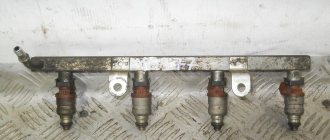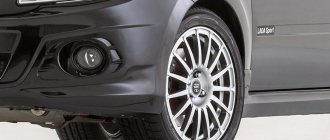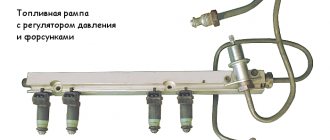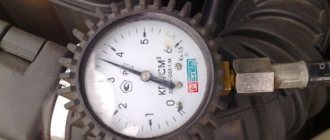Why measure tire pressure on Niva Chevrolet
Before you start measuring tire pressure, you need to decide on the units of pressure measurement. The most common are bar and atmosphere (atm.). Many people consider them identical, but this is not entirely true. If we take one normal atmosphere (760 mm Hg) as 1, then 1 bar will be 1.0133 atm. The difference of less than 2% is caused by the peculiarity of the mmHg conversion. Art. to Pascals in the SI system. All modern pressure gauges are marked in bars or atmospheres.
Timely monitoring of tire pressure affects:
- stability of straight motion;
- maximum braking distance of a car;
- stability and safety of control in extreme conditions;
- uniform tire tread wear;
- eliminates damage to tire sidewalls and cords;
- reduces fuel consumption at all speeds.
The pressure in Niva Chevrolet tires may be too low or too high . The behavior of the car on the road differs from this value as follows.
Important! The nominal level for wheels with landing radius R15, R16 is taken to be the factory setting of 1.9 bar.
Blood pressure is higher than normal . The car's ride becomes harsher, the contact patch with the road surface decreases, and directional stability deteriorates. The braking distance increases greatly, especially on wet or slippery surfaces. Characteristic bald spots appear on the tread in the middle of the wheel. An overinflated wheel is much easier to damage, and strong impacts are transmitted to the disc and suspension elements.
Underinflated wheels increase the effort on the steering wheel of the car and significantly increase gas mileage. The behavior of the SUV on hard surfaces becomes slack, the car yaws and floats on the road at high speed. The tread wears out from the edges of the tire, and the sidewall becomes cracked. Such a wheel cannot protect the disc from a strong impact when falling into a hole.
Advice. If the pressure on all wheels is not uniform, the car will pull towards the flat tire.
The causes of flat tires are universal for all brands of cars - punctures, damage to the beads, curvature of the wheel rim, air leakage through the valve, drying out and loss of tightness of tires due to age.
What pressure should the Niva tires have?
One of the important aspects of a safe ride is the correct tire pressure. Car enthusiasts often do not pay special attention to such a small thing as pressure. But this is far from a trifle, and with an inappropriate wheel inflation index, not only the car, but also the passengers can suffer.
Also interesting: Supertest of 10 “rogues”: whose all-wheel drive is better? — 4WHEELS — MirTesen media platform
Sometimes even experienced drivers do not know exactly how many atmospheres should be in the tires of their own car. Each car has its own indicators regarding the optimal tire pressure. And they may differ on the front and rear wheels. This is explained by the fact that when the car is loaded, more load is placed on the rear tires. Therefore, the pressure in them is usually higher than in the front ones.
Inflated wheel
Each vehicle undergoes many tests before reaching auto stores. And among them there are tests for optimal tire pressure. Each individual car has its own standards regarding the amount of atmospheres in the wheel.
And they are indicated by the manufacturer on the gas tank hatch or on the driver's door. It clearly states the optimal indicators for minimum and maximum vehicle load.
It is these parameters that vehicle owners need to adhere to.
Those drivers who are fans of Niva should pay special attention to pressure indicators.
This is because the car has a high center of gravity.
It is difficult to control in an emergency situation, such as a sharp turn, as it is not very stable. Therefore, it is necessary to monitor and check the amount of atmosphere in a tire once a week.
For such measurements there are special pressure gauges, which are:
- mechanical;
- electronic;
- rack and pinion
Mechanical models are considered more durable, but often have measurement errors.
They don't need a power source, which is another plus. Electronic devices have virtually no errors, but are dependent on batteries that can run out at the wrong time. Rack and pinion pressure gauges are considered very inconvenient to use, but they do not allow for inaccuracies. Few people use them because they are very fragile.
The pressure in the Chevrolet Niva wheels on the front and rear axles is no different. For example, the optimal indicators correspond to 2.1 atmospheres, and at maximum load they increase to 3.0.
However, these standards may vary depending on the radius of the wheel. In winter, you can reduce the pressure slightly, by about 0.2 bar. This helps the hard rubber handle the road and increase the contact patch area.
In summer, atmospheric indicators should be kept within the recommendations
Many people consider the Chevrolet Spark to be a toy car, but this is not at all true. It doesn’t have much power, but it can quickly dodge at a traffic light. The recommended tire size for it is from R13 to R15.
In summer, you need to inflate all wheels to 2.2 Bar, and in winter to 2.1 Bar.
If you do not adhere to such indicators, then if the car is under-inflated, it will be difficult to control, and it will skid when turning, especially in winter.
When the atmospheric indicators are different in all tires, then this is the worst thing that can happen to the wheels.
In such a situation, underinflated tires will literally drive sideways, and fuel consumption will increase significantly. When the number of atmospheres does not match the recommended standards, this can lead to:
- tread wear;
- premature tire wear;
- deterioration of controllability;
- failure of the car's chassis;
- excessive fuel consumption.
So it’s better to adhere to these standards than to spend money on new spare parts and tires.
It is necessary to check the pressure only when the tires are cold, otherwise the pressure gauge will show an incorrect result.
The machine must be at rest for at least three hours for the pressure readings to become clear. As the tire heats up, the volume of air inside it also increases, so for accurate readings you need to take measurements on cold tires.
In the case of a Chevrolet Aveo, tire pressure varies significantly depending on the tire size. So, for example, in wheels R13-R14 the number of atmospheres should be 2.1 Bar. And with increased load it increases to 3.0 Bar. But tires of size R15-R16 require an increase in indicators to 2.
In the summer, hot weather causes the air to heat up and tire pressure to increase slightly. Therefore, you can underinflate the wheels by about 0.2 Bar. Before every long trip, it is worth checking the indicators in all four wheels and in the spare tire.
If you don’t want to fool your head with constant measurements, then you can simply buy a pressure control system that will do everything automatically.
If you don’t want to spend a lot of money on such a system, you can purchase mechanical controllers that screw onto a nipple. As the pressure drops, the color of the cap changes. This device does not notify of violations of standards. Only visual control is possible behind it.
Pressure meter
Cruze cars may have tires of size 15, 16, or 17. The optimal pressure should be 2.2 bar. These parameters apply to both the front and rear axle wheels.
The table on the car body indicates that the minimum fuel consumption is achieved at 2.7 Bar.
On the one hand, this is good, but on the other hand, there will be an increased load on the suspension and the middle part of the tread, which will wear out intensively.
Also interesting: Great Wall H5, review, technical specifications, reviews, advantages and disadvantages
These parameters are suitable for fast movement on the highway, but for ordinary city roads it is better to stick to 2.2 bar. Therefore, it is not worth maintaining high blood pressure unnecessarily for a long time. This may still be justified when the machine is heavily loaded. Then increasing the number of atmospheres is simply necessary, since the tires are under heavy load.
All experienced motorists recommend following the manufacturer's recommendations regarding optimal tire pressure. If the wheels on the car are factory, then there is no need to deviate from the provided standards. But if the car was refitted with other tires of a different size, then the indicators may vary slightly. It all depends on the recommendations of the tire manufacturers.
If no more than four people travel in a car, then the number of atmospheres should be 2.1 bar. And when the car is fully loaded, you need to pump it up to 2.4 Bar. Such brands of cars are often produced with a built-in pressure control system. Therefore, it is much easier to follow the standards, since all measurements are taken automatically.
Consequences of incorrect tire pressure
This brand of car has a fairly large size and weight, so the atmosphere indicators in tires are higher than those of the previous models under consideration. The manufacturer recommends maintaining a value of 2.4 Bar in all four wheels. And when the load increases, raise it to 2.7 Bar.
But many car enthusiasts complain that when the wheels are inflated this way, the car drives harshly and a rattling sound is heard inside the cabin.
Therefore, on forums you can often find advice from drivers who recommend pumping the wheels to just 2.0 bar. With such indicators, the car drives smoother and there is no discomfort while driving. Convenience may be higher, but tire wear still increases. And fuel consumption will increase slightly.
It is necessary to monitor the pressure in your tires regularly. Failure to comply with the standards specified by the car manufacturer can affect not only the wear of car parts, but also the safety of the driver and his passengers. You need to be especially careful when choosing a pressure gauge. It is better to purchase a more expensive option with a high accuracy class than to later suffer from incorrect readings from a cheap model.
The tire pressure of any car is not just the key to a comfortable ride. Maintaining the correct level of air in the tires of any vehicle is, first of all, the safety of the driver and passengers on the road.
Also, incorrect tire pressure can cause problems in the operation of the entire chassis and wheelbase of the vehicle. Therefore, this indicator should be monitored regularly. Next, we will consider how this should be done on a Chevrolet Niva car, and what the consequences of incorrect indicators are.
Car tire pressure monitoring
Instruments and methods for measuring pressure
Chevy Niva tire pressure measurements are carried out with any mechanical or electronic pressure gauge:
- Mechanical dial pressure gauges are considered simple and unpretentious devices. The operating principle is based on a cylinder with a piston and a spring, and an arrow associated with it. Measuring range from 0.1 bar to 8 bar. The disadvantage of pointer instruments is the low measurement accuracy and dependence on the ambient temperature (underestimates readings in winter). Pros: reliable and cheap, do not require a power source.
- Electronic or digital pressure gauges . Modern high-precision instruments. Models from well-known manufacturers have minimal errors. Equally accurate in winter and summer. Cons: high price, less reliability.
Important! Measurements are made with a stationary vehicle and cold tires. After driving, you should let the car sit for 2-3 hours in summer or up to half an hour in winter. The correct order of measurements is indicated in the instructions for the pressure gauge.
The disk-tire system is not completely sealed, especially on off-road vehicles , which include the Chevrolet Niva. Air under pressure will always find a place to escape, so such pressure checks should become regular, and not 1-2 times a year when changing tires. The optimal mode is to check once every 2-3 weeks, before a long trip and after off-road trips.
Advice. Many drivers forget about the condition of the spare tire and only remember it when changing it. A deflated spare wheel will not help if a tire punctures, and you will only be able to drive a deflated wheel for a few kilometers, after which the tire will most likely have to be thrown away.
Off-road wheels on Chevy Niva
The difference between special off-road tires and all-season tires lies in a different power structure and standard size. Among the manufacturers of mud tires for Chevrolet Niva, BFGoodrich, Cordiant, Forvard, Federal Mogul and others have proven themselves well. They produce tires in sizes 215/65/R15, 215/75/R15, 225/65/R15, which fit on the Niva with minimal modifications to the standard wheel arches. Tread type M/T or A/T.
Off-road tires are distinguished by increased lugs and a reinforced tire sidewall . In addition, it is elastic and works well when deflated to a minimum. The working pressure of mud tires directly depends on the type of terrain being overcome. On rocky soils it is recommended to pump up to 2.3-2.5 atmospheres. This increases the ground clearance and traction properties of the tires. On muddy ground, sand or snow, the pressure is released to 0.8-1 bar. The tires roll well and allow you to overcome very difficult areas.
Niva Chevrolet and low pressure wheels
Low-pressure tires or arched tires are highly specialized tires that are designed primarily for constant use in severe off-road conditions, in swampy areas, and deep snow. They differ from ordinary off-road wheels in their width, light weight, and the normal pressure in such wheels is 0.5-0.7 bar.
It is impossible to install low-pressure tires on a standard Chevrolet Niva without modifying the car . You will need to lift the car and suspension, change the main pairs, strengthen the suspension elements, and install a pumping system. Such tuning turns the Niva into an excellent rogue on any terrain.
Disadvantages of low pressure tires in everyday use:
- short wheel life;
- reduction of maximum speed;
- deterioration in controllability;
- decreased reliability of the vehicle transmission;
- transfer of the car to the section of self-propelled vehicles;
- increased gasoline consumption.
What pressure should be set in tires
Setting normal tire pressure will reduce vehicle maintenance costs by reducing fuel consumption and tire wear. In addition, the driving safety and maneuverability of the vehicle depend on the tire pressure.
The tire pressure for cars with an R 15 rim should be 1.9 kg/cm², and for a R16 rim, slightly higher than 2.0 kg/cm². On Chevrolet Niva cars with 4x4 axles in off-road conditions, as well as in winter when driving on loose snow, you can reduce the pressure to 1.2-1.5 kg/cm². On a flat, high-speed highway, many increase tire pressure by 0.1-0.2 kg/², although this leads to stiffer car suspension and reduces ride comfort.
Using a vehicle with tire pressures other than normal can lead to the following consequences:
- Increased wear on the vehicle's suspension and chassis parts.
- Driving on a flat tire will increase gas mileage because the tire has more contact with the road surface and the engine needs to develop more power. Due to this, tire wear will increase.
- With high tire pressure, contact with the road decreases and driving becomes unsafe, especially in winter.
Consequences of incorrect tire pressure
Most car owners should remember the manufacturer's recommended tire pressure value for Chevrolet Niva - 1.9 bar . This is a normal value that should be used as a starting point when making adjustments up or down. Minor deviations will not lead to adverse consequences. There may be an increase in fuel consumption or slight discomfort in the car interior.
But deviations from the norm of 0.5 atmospheres or more already have a serious impact on safety and controllability and cause increased tire wear. To avoid this, it is recommended to always have a high-quality pressure gauge in your car and regularly measure the pressure in all wheels, including the spare tire.
Consequences of incorrect tire pressure
Neglecting the pressure in the wheels of a Chevrolet Niva can lead to a number of negative consequences for both the car itself and its owner. The most significant of them:
- premature wear of the chassis with inevitable failure of one or another of its parts - caused by increased load;
- if the pressure is too low, fuel consumption increases, which directly depends on the area of contact of the rubber with the road;
- an excessively widened tread prevents the car from moving normally;
- to overcome obstacles, the motor is forced to develop more power;
- if the pressure is too high, then due to poor traction the risk of getting into an accident increases;
- lateral tire wear due to flat tires;
- accelerated tire wear on hard surfaces is the result of low pressure.
Timely adjustment of the pressure level, in accordance with the recommendations specified in this article, will help to avoid all these problems.
Every car owner knows that the air in tires must be at a certain pressure.
The pressure standard is determined by the manufacturer. Deviation from which significantly affects the quality and safety of movement in a car.











